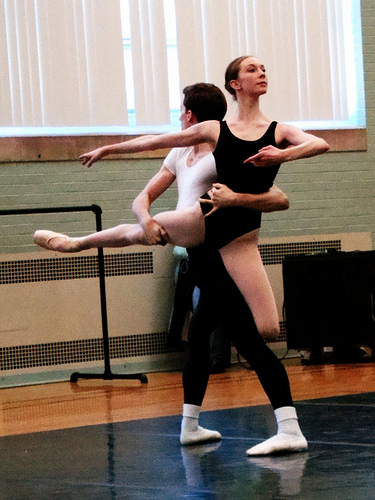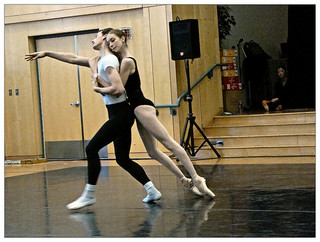Partnering was my most favorite part of being a professional ballet dancer.

I loved working closely with my partners and feeling the progress in our ability to work together. The feeling of complete synchronicity onstage was sublime and having someone to interact with emotionally and dramatically was more fun for me than dancing alone- that interaction relaxed me, which helped my dancing.
But this came after years of experience with some truly great partners. My first few experiences in summer intensives were far from that: I didn’t know what I was doing, my partners didn’t know what they were doing, and the result was often a combination of embarrassment, confusion, and chaos. Not exactly a recipe for ultimate success!
But partnering gets easier than it seems in the beginning and this post aims to help both men and women go into the partnering experience with a clear idea of how to get the most out of it. The first thing to note is that it takes years of experience for men to become good partners, and for women to become easy to partner. So don’t be in a rush for perfection. Instead, approach partnering as a long-term project that will improve over time until one day, it seems almost like second nature.
Until then, here are a few tips that can help prepare you for the experience of partnering this summer:
Be Friendly
Introduce yourself to your partner and shake hands. This takes some of the awkwardness out of the experience. Both women and men are nervous about partnering- no one likes not knowing what to do or why! It’s okay to smile or laugh when things don’t go well and it can help put your partner at ease. You’re there to learn, so take a deep breath and put your pride behind you.
50% Technique & 50% Communication
Learning to communicate effectively with your partner is 50% of any successful partnership. When something doesn’t work, don’t blame your partner. Even if you think it’s his/her fault, blame results in frustrated or hurt feelings that help no one. Instead, start with a description of what you felt: “I felt like I was falling to the left” or “I felt too far away.” Then ask questions: “Did you feel that too?” or “Why do you think that happened?” Notice how the description starts with “I” statements- this is an important part of not placing blame on your partner. (As opposed to “You didn’t keep me on my leg” or “You were too far away.”) Once you both agree on what’s happening, you can start problem solving from an objective (and not emotional) perspective.
I was partnered in my first job by a really outstanding principal dancer who taught me about this way of communicating and it turned out to be one of the most important things I learned from him. By distancing myself emotionally, I was able to focus on solving the problem. As a result, I was an easy person to partner and I got paired up with all kinds of dancers. (P.S. Being a dancer that everyone wants to partner means you have more opportunities to dance!)
Accidents
Small accidents happen a lot with young partners: a stray knee, a misguided grab. If you hurt your partner, be sure to apologize and make sure he/she is okay. Again, stay away from accusing statements, even if you think your partner was at fault.
Know the Combination
Gentlemen: if your teacher hasn’t been clear about hand placement, ask before the combination starts. Be sure you understand intellectually what you’re being asked to do. It might take your hands time to fully execute on that message, but if you aren’t even sure about it, then you’re bound to have a problem.
Ladies: Same thing: there is nothing more awful than not jumping when your partner thinks you’re going to or whipping your leg out of passé when he’s not expecting it. Be sure you understand the combination before you start so that no one gets hurt.
Ask Questions
Your teacher(s) will be ready for all of your questions about how to fix problems and tweak small issues. If you consistently have a problem with something, ask your teacher to watch. Rather than saying, “He/she is having trouble” try “We are having trouble.” When you’re in a partnership, you are working together, so until you both get it, neither of you do. In the beginning, with two partners who are inexperienced, sometimes you can’t problem solve alone- you’ll need the valuable input of a teacher.

Partner Everyone; Be Partnered by Everyone
Although certain body types and heights are more obvious matches than others, it’s a good idea to let yourself partner and be partnered by many different people rather than just one. Each partner I worked with taught me something different and had unique insight into how we worked together, even the ones who were considered “too short” for me. Eventually, your teachers will pair you up, so you might as well learn from as many people as you can before that happens!
Practice, Practice, Practice!
Partnering is one of those things you have to do in order to improve and summer intensives offer a great opportunity to practice a lot. Find someone you work well with, and keep trying out the combinations in class. Unless you are doing big lifts, which are tiring and require rests, keep attempting the promenades, pirouettes, and other less taxing combinations until you both feel comfortable. I remember rarely standing still during a partnering class: I was always trying things with whoever was game and wanted to practice.
Have fun!
If any of this has been helpful to you, we would love to hear about it!
Elizabeth is a former professional ballet dancer who danced with the Cleveland and Boston Ballet Companies. She is the Founder & Director of The Dancer’s Toolkit, a company dedicated to supporting young dancers in achieving their personal and artistic goals while maintaining optimal physical and mental health. She works with dance students both privately and in dance schools in and around NYC. Visit Elizabeth’s blog at www.centeredstage.com.

Dance Advantage welcomes guest posts from other dance teachers, students, parents, professionals, or those knowledgeable in related fields. If you are interested in having your article published at Dance Advantage, please see the following info on submitting a guest post. Read posts from guest contributors.

